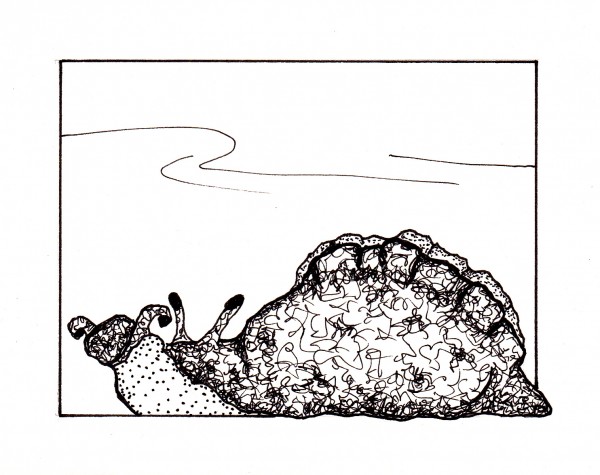By Mia Davidson and Jan Sattler
 The California sea hare (Aplysia californica) derives its name from the four protrusions on either side of its head that are suggestive of rabbit’s ears. The slow moving gastropod resembles a giant slug and is typically eight inches long but can reach up to 16 inches. Colored a mottled purplish-brown, it is fleshy and soft and has a velvety texture. There are two ruffled flaps (parapoda) running along the top of its back and a grasping foot along the underside of its body. Lacking an external shell, this sea hare is one of the largest gastropods in the world.
The California sea hare (Aplysia californica) derives its name from the four protrusions on either side of its head that are suggestive of rabbit’s ears. The slow moving gastropod resembles a giant slug and is typically eight inches long but can reach up to 16 inches. Colored a mottled purplish-brown, it is fleshy and soft and has a velvety texture. There are two ruffled flaps (parapoda) running along the top of its back and a grasping foot along the underside of its body. Lacking an external shell, this sea hare is one of the largest gastropods in the world.
Found offshore in water up to 60 feet deep and occasionally in the sheltered area of the tidepools when the tide is low, the California sea hare feeds in daylight hours using its radula (rasping tongue) to scrape off algae and can often be found near its food source. The sea hare is an herbivore that as a juvenile, grazes on red algae in the deeper water. As it grows, it moves to the shallower water of the low intertidal zone where it forages on eelgrass and a variety of algae which causes the color variation in its appearance. When disturbed or attacked, the sea hare produces a cloudlike magenta ink that acts as a decoy and repellant to its predators which include giant green sea anemones, some crustaceans and a few fish.
Although California sea hares are hermaphrodites (having both male and female sex organs), they require a separate mate to procreate. Offshore in large breeding groups, they aggregate in chains that alternate female and male with a female always at the head of the chain and the male at the end. Laying millions of eggs that resemble a jumble of bright yellow spaghetti in the rocks and seaweed, the eggs hatch in 10 to 12 days. Spawning in late spring and summer, they generally die shortly after egg laying. Aplysia californica is widely studied because they have very large neurons, which makes it possible to study nerve transmission of memory and learning. Because sea hares are so easily damaged by human activity, Laguna Ocean Foundation tidewater docents and tidepool educators discourage touching the animals.
Residents and year-round ocean swimmers Mia Davidson and Jan Sattler are committed to a sustainable marine and near shore environment in Laguna Beach.




